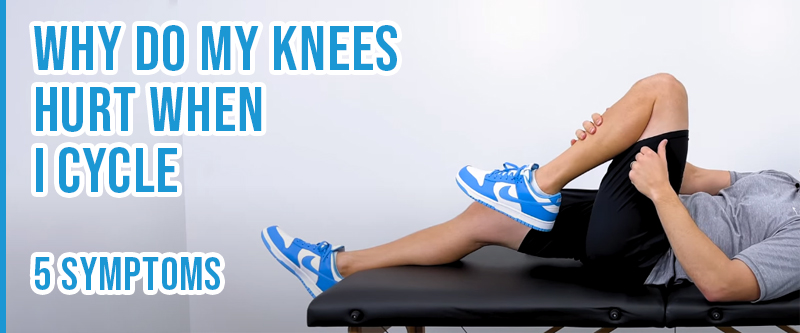Knee pain often results from aging, injuries, or repeated stress on the knee joint. Common issues include ligament sprains, cartilage tears, tendonitis, and arthritis. Studies report knee pain incidence ranging from 36% to 62%, making it the second most common overuse injury for cyclists (after Cyclist’s Back).
Patellar tendonitis occurs when the tendons supporting the kneecap are injured, or the surrounding muscles are imbalanced. It can cause knee pain during cycling. Treatment involves icing the area and avoiding activities that aggravate the knee.
This article will explore why your knees might hurt when you cycle, the symptoms, and when to seek medical attention for knee pain caused by cycling.
Why Do My Knees Hurt When I Cycle: 5 Key Symptoms
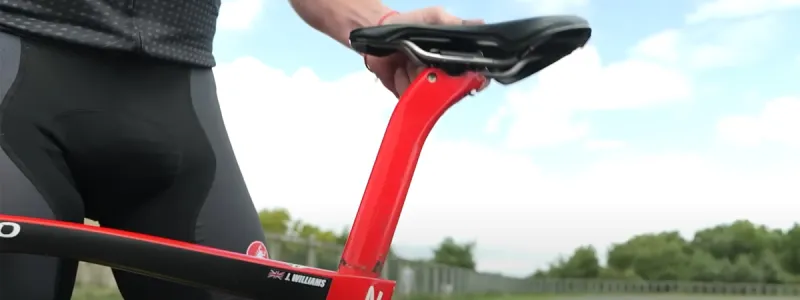
Regarding cycling, knee pain can make the experience uncomfortable and frustrating. Multiple factors may contribute to this issue. We will explore some of the most common causes of knee pain in cycling.
Bending and Straightening Knee Pain
Cyclists often complain about experiencing knee pain while bending and straightening their knees. This pain can make cycling less enjoyable and may discourage you from continuing this beneficial exercise.
Pain after knee popping
Another issue that some cyclists face is a sensation of popping in the knee followed by pain. This can be quite alarming and should not be ignored. A popping feeling followed by pain could be because of a meniscus tear or a dislocated kneecap.
The menisci are stiff pieces of cartilage that connect your thighbone and shinbone. They can tear if you suddenly twist your knee while bearing weight on it.
Knee Pain in Cold Weather
You might also notice that your knees hurt more when it is cold outside. This is a common problem and can make winter cycling less appealing.
Cold weather can make joints stiff and less flexible. This is because the barometric pressure drops in colder weather, which can cause your joints to expand and pressure your nerves, leading to discomfort or pain.
Incorrect Saddle Height
An incorrect saddle height is a common cause of knee pain while cycling. The saddle height is the distance between the saddle’s top and the pedal axle’s center. An incorrect saddle height can cause anterior knee pain, a pain in the front of the knee often felt after a ride. This pain can arise due to overextending or flexing the knee.
Signs that Your Saddle Height May be Incorrect:
- The front of the knee hurts after cycling.
- Knee pain that increases with cycling.
- Feeling like you can’t get enough “drive” from your legs.
- Pain in the lower back while cycling.
Foot Placement and Footwear
While less common than saddle height, improper foot placement and footwear can contribute to knee pain while cycling. Proper foot placement refers to where your foot is positioned on the pedal, while footwear relates to your shoe type.
Improper Foot Placement
Improper foot placement can lead to medial and lateral knee pain, pain felt on the inside and outside of the knee, respectively.
Signs of Improper Foot Placement
- Pain inside or outside your knee during or after cycling.
- Feeling as though your knees are rubbing against the top tube of your cycle.
- Generally feeling “off balance” on the cycle.
Improper Footwear
Wearing improper footwear while cycling can also contribute to knee pain. Shoes that are too flexible or lack support can strain the knee joint unnecessarily.
Signs of Improper Footwear
- Knee pain after cycling that lasts for an extended period.
- A feeling of instability while pedaling.
- General foot pain or fatigue while cycling.
Muscle Imbalances and Tightness
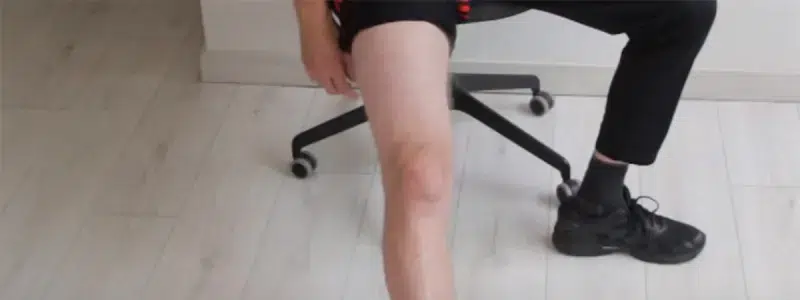
Muscle imbalances occur when specific muscles are stronger or weaker than others, leading to improper movement patterns while cycling. Conversely, tightness refers to forces that are tensed up or contracted, reducing their ability to function correctly. These imbalances and tightness can cause many problems, including the following:
- Anterior Knee Pain: Tight quadriceps muscles and weak hamstrings can cause the front of your knee to hurt.
- Medial and Lateral Knee Pain: Weak inner or outer thigh muscles can cause discomfort inside or outside the knee.
- Reduced Cycling Performance: Muscle imbalances and tightness can reduce power output, leading to slower speeds and decreased endurance.
Training Errors and Overtraining
Another common cause of knee pain during cycling is training errors and overtraining. Increasing the distance or intensity of your cycling workouts too quickly can lead to discomfort and injury. Here are some points to consider:
- Overtraining can cause knee pain and other injuries, such as tendonitis or IT band syndrome.
- A sudden increase in intensity or distance can cause discomfort.
- Rest and recovery are essential for avoiding knee pain and other injuries.
Pedaling Mechanics and Gearing
Pedaling mechanics and gearing are critical factors in determining the strain and stress your knees will experience during a cycling session. Here are some significant points to consider:
- Improper pedaling technique can strain your knee joint unnecessarily, leading to discomfort and pain.
- Incorrect gearing may also contribute to knee pain. For example, if you cycle at too high a gear, you might use too much force, leading to knee pain or injury.
- Attention to pedaling mechanics can help prevent anterior and posterior knee pain during cycling.
Saddle Positioning and Cleats
Saddle positioning and cleats can significantly affect knee pain while cycling. When cycling, here are some crucial points to consider:
- Incorrect saddle positioning can strain the knees during a cycling session, causing discomfort and even injury.
- Cleats, which hold your feet to the pedals, also play a role in knee pain while cycling. You may experience medial or lateral knee pain if your cleats are not correctly positioned.
- Adjusting the saddle angle can also ease discomfort during a cycling session.
Additional Reasons My Knees Hurt While Cycling
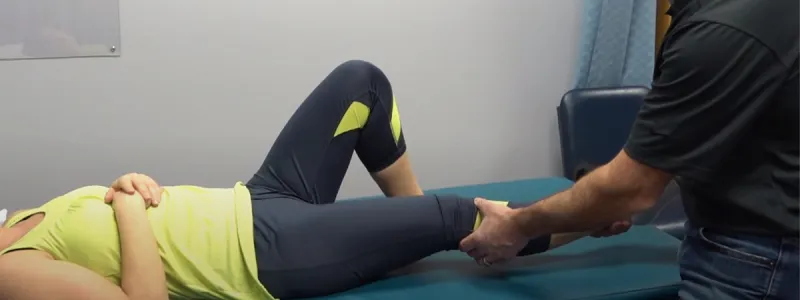
- Stiffness and Pain in the Knee: Feeling stiffness and pain in your knee while cycling can be quite uncomfortable. Your mobility will be limited, making it hard to enjoy your ride.
- Sore Knees After Cycling: Experiencing sore knees after cycling is another common complaint among cyclists. This post-cycling pain can damper your enthusiasm for the sport. Sore knees after cycling can result from overuse or strain. This is common in cyclists who recently increased their riding intensity or distance.
- Arthritis: Arthritis can cause pain in the knee. The repetitive cycling motion might exacerbate the symptoms of this inflammatory joint condition, leading to discomfort during or after a ride.
- Infections Around the Knee: Sometimes, conditions in the bones around the knee can cause pain. While these are not directly related to cycling, they can make taking part in the activity uncomfortable.
- Dislocated Kneecap: A dislocated kneecap is a serious injury that can cause severe knee pain. If you’ve experienced a fall or collision while cycling, this could cause discomfort.
- Meniscal Tear: The meniscus is a crucial knee cartilage cushioning and stabilizing. With a tear in this cartilage, one may experience pain, particularly while engaging in activities such as cycling.
- Ligament Strain: Cycling requires a lot of leg strength, and overworking your muscles can lead to ligament strain and inner side of knee pain. Especially if you push yourself too hard or don’t use proper form.
- Overuse: Simply put, cycling too much without adequate rest can lead to overuse injuries. These can manifest as knee pain and might signal that you must take a break and let your body recover.
5 Symptoms of Knee Pain When Cycling
While cycling is a low-affected and beneficial exercise, some individuals may experience knee pain during or after their rides. This discomfort can manifest in various ways and might be accompanied by other symptoms. You can identify potential problems if you recognize these signs and seek treatment. Here are some common symptoms that can accompany knee pain:
- Swelling and Stiffness: One of the first signs of a problem could be swelling around the knee joint. This can make your knee feel stiff and make it tough to pedal effectively.
- Redness and Warmth: If your knee becomes red and feels warm to the touch, this could signify an inflammation or infection. This symptom should not be ignored, as it might indicate a more serious underlying issue.
- Weakness or Instability: A sense of weakness or instability in the knee can signify a strain or injury. Stopping and assessing the situation is crucial if you feel your knee might give out while cycling.
- Popping or Crunching Noises: Hearing unusual sounds from your knee, like popping or crunching noises, should raise a red flag. These sounds can show a problem with the cartilage or bones in the knee joint.
- Inability to Fully Straighten the Knee: Fully extending your leg or straightening your knee is another symptom to watch out for. This might indicate a severe injury or condition that requires medical attention.
Knee Hurts When Cycling At Different Positions
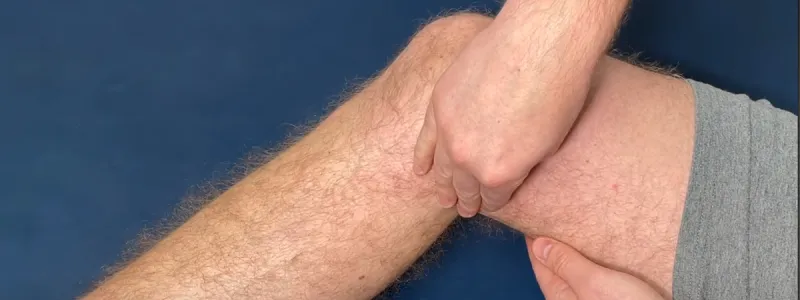
Cycling can be a fantastic workout, but it can quickly lose its appeal if you’re experiencing knee pain. Not all knee pain is the same, though. The location and nature of your discomfort can tell you a lot about its cause. Below are some knee injuries caused by cycling at various angles.
Pain Behind the Knee
Pain behind the knee while cycling can be uncomfortable and may limit your ability to pedal. This type of pain is often caused by overextending your knee. This can happen if your bike seat is too high, forcing your leg to stretch more than it should with each pedal stroke. It could also be because of a hamstring strain, as these muscles are at the back of your thigh and connect to the knee.
Pain on the Inner Side of the Knee
The inner side of your knee can be a concern and affect your ability to cycle effectively. This type of pain could be caused by Pes Anserine Bursitis, where the bursa on the inner side of your knee becomes inflamed. Overuse or stress from cycling can cause this. Incorrect foot position on the pedals can also lead to inner knee pain.
Knee Hurts Above Kneecap
Cycling can lead to pain above the kneecap, often because of an inflammation of the tendon connecting the quadriceps muscle to the kneecap. Patellofemoral Pain Syndrome (PFPS) can also cause kneecap pain after cycling because of stress on the knee joint. Incorrect bike fit or improper pedaling technique can also contribute to this pain.
Knee Pain From Cycling: When To Get Medical Advice
Experiencing knee pain while cycling can be shared, but knowing when this discomfort crosses the line into serious territory is essential. Some sure signs and symptoms warrant immediate medical attention. Let’s look at some scenarios when you should call your doctor:
- Can’t Support Weight or Knee Feels Unstable: If putting weight on your knee causes intense pain or if your knee feels unstable and prone to giving out, it’s time to see a doctor. This could be a sign of a severe injury that requires professional care.
- Significant Swelling in the Knee: While some swelling is normal after physical activity, noticeable knee swelling could show a more severe condition. If your knee is significantly swollen, getting it checked out is essential.
- Limited Ability to Move the Knee: It could indicate a potentially severe issue if you can’t straighten or bend your knee fully. Don’t ignore this symptom; consult with a healthcare professional.
- Obvious Deformity in Your Leg or Knee: Any visible abnormality in the shape of your leg or knee is a clear signal that something’s wrong. A fracture or other serious injury could warrant immediate medical attention.
- Fever Along with Redness, Pain, and Swelling in Your Knee: A fever, accompanied by pain, swelling, and redness, could be a sign of an infection. This is a severe situation that requires urgent medical care.
Conclusion
Staying active and healthy is excellent, but knee pain can hamper enjoyment. Understanding the various factors contributing to knee pain is essential for preventing it.
From adjusting your saddle and cleat positions to improving your pedaling mechanics and correcting muscle imbalances, there are multiple ways to alleviate knee pain while cycling.
By adhering to the golden rule, which emphasizes the importance of correct positioning and proper training, you can protect your knees and enjoy cycling without discomfort. You can set yourself up for optimal knee health and cycling performance with the right approach.
FAQs
Why Do My Knees Hurt As a Teenager and Young Adults When Cycling?
Why Do Some Ladies Experience Knee Pain?
A cause of joint stress in women could be wider hips and slightly knock-kneed thighs, which can add pressure to their joints. Muscle strength may also play a role.
Why Does Cycling Hurt My Knee After A Hip Replacement?
Knee pain post-hip replacement can occur because of changes in leg length or altered biomechanics. The surgery may affect sensory nerves that provide sensation to the knee, leading to discomfort during activities like cycling.

